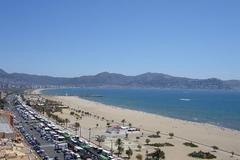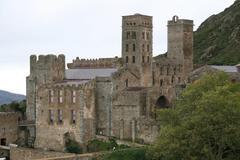Guide to Visiting Torre de Norfeu in Roses, Spain
Date: 01/08/2024
Introduction
Nestled within the picturesque Cap de Creus Natural Park near Roses, Spain, the Torre de Norfeu stands as a monumental testament to the region’s rich maritime history and defensive architecture. This historical watchtower, dating back to the early 17th century, was erected as a safeguard against the rampant piracy that plagued the Mediterranean coast. Built around 1604, the Torre de Norfeu was a crucial part of a defensive network designed to protect the Gulf of Roses (Costa Girona).
Strategically positioned on the Cap Norfeu peninsula, the tower offered expansive visibility over the Mediterranean Sea, making it an essential lookout point for detecting pirate ships and other potential threats. Its robust construction, characterized by thick stone walls, enabled it to endure various assaults, thereby playing a pivotal role in the coastal defense system (Komoot).
Over the centuries, the Torre de Norfeu has evolved from a functional military structure to a cultural symbol and a popular destination for history enthusiasts and hikers alike. Despite its partial ruin, the tower remains a significant monument within the Cap de Creus Natural Park, attracting visitors who are eager to explore its storied past and enjoy the breathtaking views of the surrounding landscape (Visit l’Escala).
This guide aims to provide a comprehensive overview of visiting the Torre de Norfeu, covering its historical background, visitor information, travel tips, and the significance of ongoing preservation efforts. Whether you’re a history buff or a nature lover, the Torre de Norfeu offers a unique blend of historical intrigue and natural beauty that promises an enriching experience for all visitors.
Table of Contents
- Introduction
- Historical Background
- Visitor Information
- Preservation Efforts
- Educational Value
- Visitor Experience
- FAQ
- Conclusion
- Call to Action
Historical Background
Origins and Construction
The Torre de Norfeu, located in the Cap de Creus Natural Park near Roses, Spain, is a historical watchtower with origins dating back to the early 17th century. Built around 1604, the tower was part of a broader defensive network designed to protect the Gulf of Roses from pirate attacks. During this period, piracy was a significant threat to coastal settlements in the Mediterranean, necessitating the construction of such fortifications (Costa Girona).
Architectural Features
The Torre de Norfeu was originally constructed as a two-story circular tower. Its design was typical of the period, featuring thick stone walls to withstand attacks and provide a vantage point for spotting incoming threats. The tower’s strategic location on the Cap Norfeu peninsula allowed for extensive visibility over the Mediterranean Sea, making it an essential part of the coastal defense system (Komoot).
Defensive Role
The primary function of the Torre de Norfeu was to serve as a lookout point and signal tower. Guards stationed at the tower would keep watch for pirate ships and other potential threats. Upon spotting danger, they would light fires or use other signaling methods to alert nearby settlements and other towers in the network. This early warning system was crucial for the safety and security of the coastal communities in the Gulf of Roses (Costa Girona).
Decline and Preservation
Over the centuries, the Torre de Norfeu fell into disrepair as the threat of piracy diminished and newer forms of defense were developed. Today, only the first of the two original floors and the outer wall remain standing. Despite its dilapidated state, the tower is a significant historical monument, offering insights into the region’s past and its defensive strategies (Costa Girona).
Cultural Significance
The Torre de Norfeu is not only a historical structure but also a cultural symbol. It is part of the rich tapestry of the Costa Brava’s history, reflecting the region’s struggles and resilience against external threats. The tower’s enduring presence serves as a reminder of the area’s maritime heritage and its strategic importance in the Mediterranean (Visit l’Escala).
Legends and Myths
The Cap Norfeu, where the tower is located, is steeped in legend. According to local folklore, the area is named after Orpheus, a hero from Greek mythology. It is said that Orpheus, with his enchanting music, caused the mountains near the coast to move closer to hear his melodies. This legend adds a layer of mystique to the Torre de Norfeu, intertwining history with myth and enhancing its allure for visitors (Costa Girona).
Modern-Day Relevance
Today, the Torre de Norfeu is a popular destination for hikers and history enthusiasts. The tower is part of several hiking routes in the Cap de Creus Natural Park, offering spectacular views of the Mediterranean and the surrounding landscape. Visitors can explore the remnants of the tower and imagine the historical events that unfolded in this picturesque setting (Komoot).
Visitor Information
Visiting Hours
The Torre de Norfeu is accessible year-round, but it is advisable to visit during daylight hours to fully appreciate the site’s beauty and historical significance. There are no specific visiting hours as it is an open historical site within the natural park.
Tickets
There is no admission fee to visit the Torre de Norfeu. The site is freely accessible to the public, making it an excellent option for a budget-friendly outing.
Travel Tips
- Getting There: The tower is best reached by hiking from nearby parking areas within the Cap de Creus Natural Park. Ensure you wear suitable footwear and bring water, especially during the summer months.
- Best Time to Visit: Spring and autumn offer the most pleasant weather for hiking. The summer can be quite hot, while winter might present challenging weather conditions.
- Nearby Attractions: While in the area, consider visiting the nearby town of Roses, known for its beautiful beaches and historical sites such as the Ciutadella de Roses and the Castillo de la Trinitat.
- Accessibility: The hike to the Torre de Norfeu is relatively easy but may not be suitable for those with mobility issues. The path involves some uneven terrain.
Preservation Efforts
Efforts to preserve the Torre de Norfeu are ongoing, with local authorities and heritage organizations working to maintain the site and promote its historical significance. These efforts ensure that future generations can continue to learn about and appreciate this important piece of the Costa Brava’s history (Costa Girona).
Educational Value
The Torre de Norfeu serves as an educational resource, providing valuable insights into the region’s defensive architecture and historical context. Schools and educational groups often visit the site as part of history and cultural studies programs, making it an important tool for learning and engagement with the past (Visit l’Escala).
Visitor Experience
For visitors, the Torre de Norfeu offers a unique blend of natural beauty and historical intrigue. The hike to the tower is relatively easy, making it accessible to families and individuals of all ages. Along the way, hikers can enjoy the stunning coastal scenery, diverse flora and fauna, and the sense of stepping back in time as they approach the ancient watchtower (Costa Girona).
FAQ
What are the Torre de Norfeu visiting hours?
The Torre de Norfeu is accessible year-round during daylight hours. There are no specific visiting hours as it is an open historical site within the natural park.
How much are tickets to the Torre de Norfeu?
There is no admission fee to visit the Torre de Norfeu. The site is freely accessible to the public.
How do I get to the Torre de Norfeu?
The tower is best reached by hiking from nearby parking areas within the Cap de Creus Natural Park. Ensure you wear suitable footwear and bring water, especially during the summer months.
Is the Torre de Norfeu accessible for people with disabilities?
The hike to the Torre de Norfeu involves some uneven terrain and may not be suitable for those with mobility issues.
Conclusion
The Torre de Norfeu stands as a testament to the rich history and cultural heritage of the Costa Brava. Its origins as a defensive structure against piracy, its architectural features, and its enduring presence make it a significant historical monument. Through preservation efforts and educational initiatives, the tower continues to be a valuable resource for understanding the past and appreciating the natural beauty of the Cap de Creus region (Komoot).
Call to Action
If you enjoyed learning about the Torre de Norfeu, consider downloading the Audiala app for more travel tips and guides. Follow us on social media to stay updated on new articles and adventures!
Summary
The Torre de Norfeu stands as a remarkable relic of the past, embodying the rich history and cultural heritage of the Costa Brava region. This 17th-century watchtower, originally built to protect the Gulf of Roses from pirate invasions, now serves as a poignant reminder of the region’s maritime struggles and resilience (Costa Girona).
Today, the Torre de Norfeu is more than just a historical monument; it is a beacon of cultural significance and natural splendor, drawing visitors from around the world. The tower’s strategic location within the Cap de Creus Natural Park offers unparalleled views of the Mediterranean Sea and the rugged coastline, making it a favorite spot for hikers and history enthusiasts alike (Komoot).
Efforts to preserve and maintain the Torre de Norfeu ensure that this historic site will continue to educate and inspire future generations. Its enduring presence provides valuable insights into the defensive strategies of the past and highlights the importance of preserving our cultural and natural heritage (Visit l’Escala).
For those planning a visit, the Torre de Norfeu offers a unique opportunity to step back in time and explore a significant piece of the Costa Brava’s history. With no admission fees and accessible hiking routes, it is a budget-friendly outing that promises a blend of historical exploration and natural beauty. Whether you are captivated by its storied past or the breathtaking vistas, a visit to the Torre de Norfeu is sure to be a memorable experience.
Sources
- Costa Girona. Cap Norfeu: A Route of Legend. Retrieved from https://www.costagirona.com/blog/en/cap-norfeu-a-route-of-legend/
- Komoot. Smart Tour 707706. Retrieved from https://www.komoot.com/smarttour/707706
- Visit l’Escala. Lescala and the Most Beautiful Bays in the World. Retrieved from https://www.visitlescala.com/en/lescala-and-the-most-beautiful-bays-in-the-world



